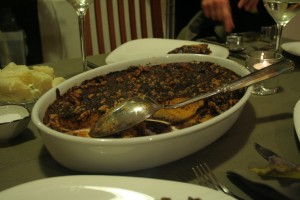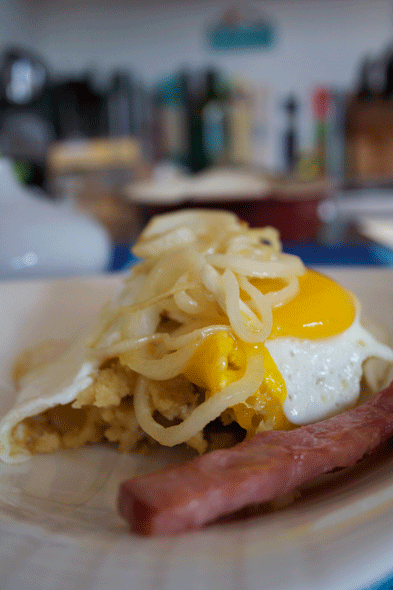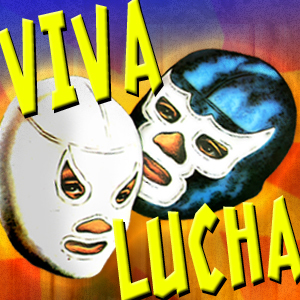Posts Tagged ‘latin food’
Fresh from the market Latino!04.09.11
You must think I’m turning all health nut on you. I realize that many of my recent entries have been focusing on healthful cooking and wholesome recipes, but that doesn’t mean I’m leaving my Latin roots behind. The truth is that this semester a Consumer Journalism class at school has opened my eyes to some of the realities of our country’s food system. Coincidentally, I’ve come across some interesting articles recently that bring fresh ideas to the Latin kitchen. One of my favorite Latin food bloggers Ana Sofía Pelaez, recently wrote about the benefits of Latin American super-grains amaranth and quinoa. Lorenza Muñoz shed some light on the vegetarian options that abound in Mexican cooking in her latest story in the LA Times. more »
Magnificent Mangú03.09.11
For me, weekends are for sleeping in, seeing friends, catching up on life and most importantly, indulging in the luxury of time. Creating elaborate breakfast dishes is such a treat that I sometimes enjoy the process more than the actual tasting (ahem, NOT). Mangú con huevo, the quintessential breakfast dish from the Dominican Republic is the perfect case in point. Mangú, or mashed green plantains, is made by boiling green plantains and crushing them with olive oil and butter until they’re soft and creamy. In the D.R., mangú is typically served with fried cheese, fried salami (a local sausage), sunny side eggs and avocado. The end result is a feast of textures: the smoothness of the egg yolk balances the density of the plantain, the cheese and salami add a salty crisp and the avocado a cool refuge for your taste buds.
As I prepared this beloved breakfast dish on a recent Saturday, I was reminded of a drive I took with the family through the Dominican countryside, as we made our way to the mountains of Jarabacoa. The morning was rainy and fresh, and we stopped at the breezy roadside restaurant Típico Bonao which lures locals from all over the country to start the day with this dish and an aromatic cup of Dominican coffee. Mangú con huevo brings back this Dominican love, and nourishes the spirit as well as the belly.
Mangú con Huevo Serves 2
2 green plantains
olive oil
butter
salt
red onion
white vinegar
4 eggs
breakfast ham
“queso de hoja” cheese (optional)
avocado (optional)
Chop the ends off each plantain. Make slits throughout the plantain, running the tip of your knife through the length of the fruit. Chop the plantains into 1″ chunks. Fill a pot with water and boil the plantain chunks for about 45 minutes.
While the plantains cook, thinly slice the onion and place the slivers in a bowl with 1 tablespoons of white vinegar, olive oil and salt. Stir these around until the onion gets covered and let it rest.
Check if the plantains are ready by piercing them with a fork. They should be tender when cooked. They will also be easy to peel. Remove their skin and place the chunks in a deep bowl. Pour a 1/4 cup of cooking liquid, a drizzle of olive oil, 1 tablespoon of butter and salt and start to mash with a masher or fork. Work through the pieces, alternating with the liquid, olive oil and butter, until you achieve your desired consistency.
Working quickly, pan fry the onions in a drizzle of olive oil and pour over the mangú. Cover with aluminum foil to keep warm. Next toss the ham, and fry the eggs sunny side up, on a non-stick pan. You can also deep fry the queso de hoja for an authentic latin kick and slice up some avocados on the side. Serve the mangú with the onions, eggs and ham. Eat immediately!
It’s Ceviche Time!11.22.10
It was time for Sunday supper in NYC.
The seafood had been chilling in the fridge, soaking up the flavors of a clear, citrus broth. This was my first attempt at preparing ceviche, the classic dish of cured seafood from the kitchens of Peru and Ecuador, and judging from the delicate flavors and textures it yielded, it would definitely not be my last. I caught the last wave of local tomatoes, dicing their bright red flesh and piling them over the succulent seafood that had been marinating for a couple of hours. On top of those juicy cubes, I added crunchy bits of green pepper, finely chopped slivers of white onion, and fragrant cilantro and parsley that turned out to look a lot like kitchen confetti.
We laid out small bowls throughout the dining table, each one filled with thinly sliced plantains, airy popcorn and chunks of crusty French bread. All these garnishes would create a symphony of textures to accompany the cool, clean dish. We bit into the plump pink shrimp, nibbled delicately on the silky mussels and popped the morsels of scallops and miniature clams into our mouths. We sipped on cold white wine, while talking and laughing.
That afternoon I had visited the food markets of the Upper West Side, and after getting home, I turned to The South American Table cookbook for guidance. The result was a light and flavorful meal: the orange and mustard in the marinade gave the seafood a sweet and tangy note, the toppings gave it crunch and a lemony freshness. The different garnishes added an interactive component that was a hit.
This weekend, a hint of Spring was in the air. It was time to venture into something new.
Shellfish Ceviche Serves 6 (I served it as a meal, but you can also make it as an appetizer at your next dinner party)
4 cups water
1 scallion, sliced
1 lb. medium shrimp, peeled and deveined
½ lb. bay scallops
¼ cup dry white wine
1 lb. mussels, scrubbed and deveined
16 baby clams
MARINADE
1/3 cup lemon juice
1/3 cup lime juice
2/3 cup orange juice
½ cup chicken broth
1 tablespoon extra virgin olive oil
1 teaspoon Dijon mustard
1 teaspoon Worcestershire sauce
½ teaspoon sugar
½ teaspoon salt
¼ teaspoon black pepper
Hot sauce
GARNISHES
1 medium tomato, peeled, seeded and finely chopped
1 small green bell pepper, seeded and finely chopped
1 small onion, finely chopped, rinsed with hot water and drained
2 tablespoons fresh cilantro
2 tablespoons fresh parsley
SIDE DISHES
Popcorn, plantain chips (chifles), French bread, ripe avocado
INSTRUCTIONS
In a large saucepan, bring water and scallions to a boil, reduce heat and simmer for 5 minutes. Add shrimp, remove from heat and let stand for a few seconds until the shrimp turn pink. Remove shrimp and rinse under cold water.
Add scallops to the cooking liquid and bring back to boil. Remove from heat, cover and let stand for 3 minutes. Once scallops are cooked through (their center should be white), drain and rinse under cold water.
Place wine, mussels and clams in large skillet and bring to boil. Cover and continue to boil until shells are open, 3 to 5 minutes. Remove clams ad mussels from their shells.
Make marinade by combining all the ingredients in a large glass or ceramic bowl. Stir in shrimp, scallops, mussels and clams. Mix well, cover with plastic wrap and refrigerate for at least 2 hours.
Before serving, taste for salt, sugar and spice. Serve with garnishes and side dishes.
Foodie Event @ NYC’s Chelsea Market11.14.10
Foodie Event @Chelsea Market from Karina Taveras on Vimeo.
This month, I had the chance to shoot and produce my first video, and cover a Book Launch and Tasting Event at NYC’s mouth-watering Chelsea Market. Twenty-five chefs from all over New York City came together to show off their stuff, choosing one recipe from The Essential New York Times Cookbook by Amanda Hesser that hit bookstores, and giving each recipe their own unique twist. The event was a blast! The chefs were incredibly warm and passionate about their creations, while the guests were devoted followers of the gastro scene in NYC.
I also had a chance to speak to Sisha Ortuzar, a young talented chef from Chile who heads the kitchen in New York’s Riverpark. He talked to me about the spicy shrimp dish he served that night: a take on a classic Pickled Shrimp recipe that he pickled in spice and topped with a brittle made from the same spices he used in the pickling process–coriander, caraway and fennel seeds.
Latin flavors dominate the scene10.22.10
The Culinary Institute of America held a seminar about Latin American food called “Latin Flavors, American Kitchens” in its San Antonio campus, with guest chefs including Rick Bayless and Maricel Presilla, two established chefs and ambassadors to Latin American cuisine in the U.S. More and more, Latin American food appears to be influencing restaurant menus throughout the country. Check out the latest newcomer to the Nuevo-Latino food scene in NYC, Nuela. Also, eaters are moving away from fine dining to more casual establishments, which has given opportunities for more Latin American restaurants to break through the market. That is some excellent news, can’t wait to see what the next knock out will be!
Read more about what happened at CIA here.
Woken up by María Sangrienta (aka Bloody Mary)06.07.10
What better way to welcome a hot summer Sunday than with a Latin-style brunch? With the Gourmet Latino Festival kicking off June 4th at the Astor Center in Manhattan, I was able to savor some of the flavorful innovations that are happening in Latin American cuisine right now throughout the city. Led by chef Aaron

Salmon With Papalo Coconut Broth and colorful Latino-inspired cocktails
Sanchez and other popular names in the world of mixology, I picked up some ideas in the Mexican kitchen (ei. use an onion studded with cloves when you make home-made chicken stock ) and witnessed the creation of original cocktails inspired from traditional Latin ingredients.
The session I attended was a “Levanta Muertos” brunch seminar, a phrase ubiquitous in Latin America, that alludes to a dish or a drink that’s supposed to “wake you up from the dead” and help with your hangover. As the first year of the festival, the turnout of people was impressive. There was not a single seat available at the long tables set up for the diners throughout the space. The event was well organized, although the setup of the space was a bit funky: I was limited to seeing the mixologists in action, but couldn’t really see the chef at work.
After a cheesy introduction that had the two hosts (Sanchez and Olson) playing a pair of drunkards at a bar, the event thankfully picked up. The first creation was a Maria Sangriente, or a Mexican version of the Bloody Mary. This drink was prepared by mixologist Steve Olson and had Mezcal, Tequila, hot chiles, tabasco sauce, salt and pepper as its principal ingredients. The drink was beautifully served in a tall glass with a half chile. It was a feast for the eyes and the palate. After my first swig, its lingering heat and balanced flavors made even a spice-adversed palate like my own second-guess itself. One thing Olson repeated throughout the class was that the key to making a levanta muertos successful is that you should use the same liquor you drank the night before. This he kept referring to as using the “hair of the dog” of the dog that bit you! Kind of weird, but probably true. To nibble on, the chef prepared a huitlacoche tamal with a saffron corn sauce. The tamal took the color of the huitlacoche ( it’s corn fungus), so its masa was a dark almost black color, but tasted heavenly, with a fluffy texture and sauce that was smokey and complex.
The courses that followed all had the colors, textures and heat of traditional Mexican cooking but with a refined twist. There was a Pepita Crusted Salmon in a Papalo Coconut Broth, which was paired with a drink from Phil Ward from Mayahuel restaurant in Manhattan. The drink echoed the colors of the dish as a clear peach elixir, prepared by mixing mezcal, Aperol, Maraschino and lime. The final tasting course was a Stuffed Sweet Plantain with Smoked Black Beans, Epazote and Crema Fresca. This was accompanied by a drink called the Marajoara Magic, by Danny Valdez, the most charismatic of the guests, who prepared a drink with Brazilian cachaca, Carpano Antina, Habanero peppers and Lime oil.
The session was educational and fun, but most of all, I walked out feeling not only impressed at how Latin American flavors can be, but most of all, very proud.
(I took the photos with my phone, the colors were vibrant in real life)
Alexia’s Pastelón11.29.09
 This is the moment you’ve been waiting for.
This is the moment you’ve been waiting for.
Throughout the past 5 days, I’ve gotten many requests for this recipe. Although we are now in the December holiday territory, I urge you to make this sweet potato casserole, or pastelón in Dominican. I got the recipe from my cousin Alexia whom I love with all my heart.(gracias alexia!) Now, it is in your hands my friends. All I can say is that once you make this, prepare to be loved, your holidays will never be quite the same again.
Alexia’s Thanksgiving Pastelón
3 cups mashed sweet potatoes
1 cup sugar
½ cup butter
2 eggs
1 teaspoon vanilla*
½ can of evaporated milk
Ground cinnamon*
Pancake syrup*
Peal the sweet potatoes, cut in quarters and boil in salted water for approx 30 minutes or until soft. Drain and mash slowly with a fork. Add the butter, sugar, evaporated milk, vanilla, cinnamon, maple syrup and the egg yolks.
Beat the egg whites and fold in the mixture. Place in baking dish.
Cover with the topping below.
Topping:
½ cup brown sugar
¼ cup all purpose flour
2 1/2 teaspoons butter (hard)
½ cup chopped walnuts
Ground cinnamon
Bake at 350F for approx. 30 minutes.
* Means: “al ojo” or approximate measurements
Marshmallow woman
When you think of Thanksgiving, what is the first thing that comes to mind? For me it’s a can of jellied cranberry, which I thought was the best cranberry sauce in the world. It is when I moved to the northeastern U.S. that I suddenly started thinking twice about it, and eventually got more snobby with my cranberry sauce, choosing more natural interpretations that could be traced back to the actual fruit. What I finally realized was that what I had been serving with turkey all those years, was a far cry from the deep burgundy sauce prepared in kitchens all over the country with sugar, water, spices and of course cranberries.
In the Dominican Republic, unless you’re somehow linked to the U.S.(have family here, have studied here, have an American spouse, etc), Thanksgiving is not a popular holiday. In my home though, the celebration was welcome every year. Mom instituted the tradition after celebrating it herself with her own family. Although the stories were always nebulous, I gathered that her father, my grandfather, had lived in Puerto Rico and had himself adopted the tradition.
Decades later, my kitchen in Santo Domingo buzzed whenever Turkey day would come along. My aunt Tiita took over one of the counters, mixing her secret “Russian” potato salad adding a little of this and a little of that until it was just perfect. Mom pulled out the glistening golden turkey for one last baste. Plantain pasteles filled with shredded chicken boiled in a huge pot. Piping hot rice with kidney beans (moro) was scooped into a huge bowl, sweet potato casserole with marshmallows toasted in the oven.
The table was set. The feast was underway. I had the task of slicing the cranberry “sauce”. I loved the feel of my knife going through the shiny jelly shaped like its can. I loved how each ring was equal to the next and I took pride in lining them up, each one resting on the next. Then families and friends who had gathered on the terrace enjoying the (hopefully) cooler breezes of November and laughing and drinking would gather round the table. My Mom would give thanks, her spirit as bright as her blond bob. We would dig into the spread of American and Dominican dishes, and forget that these moments existed only for that day.
In our minds, they would always come again, they would last forever.
Turtle Stew and Chicharrón08.06.09
At first glance, you may think this pairing comes straight out of Bizarre Foods. However, at Luz Restaurant in the Cayman Islands, these two dishes are bestsellers on the menu. Staples of the Caymanian and Honduran kitchens come together in this casual Georgetown eatery which serves traditional Caymanian fare like turtle stew and stewed conch and a list of Honduran delicacies like garnaches (corn tortillas topped with cheese, cabbage and beans), chicharrón con yuca(fried pork rinds with yucca), and carne asada (roast beef). On my last trip to this sunny sanctuary, I learned about the important Honduran presence in the Caymans and that people from the Bay Islands of Honduras have been crossing the Caribbean Sea and settling in the Cayman Islands for years.
It started in the 40’s and 50’s, when local Caymanians traveled to the English-speaking Bay Islands by catboats for food and resources limited by the arid local soil. Located about 145 nautical miles away, they were easily accessible. The Bay Islands’ history includes many disputes between Spain and England during colonial times, so much so that English is mostly spoken here despite the fact that Spanish is the official language of Honduras.
To Caymanians, Spanish is synonimous with people from Honduras. It’s incredible to think how Latin America is alive in the most unexpected of places.





Food For Thought